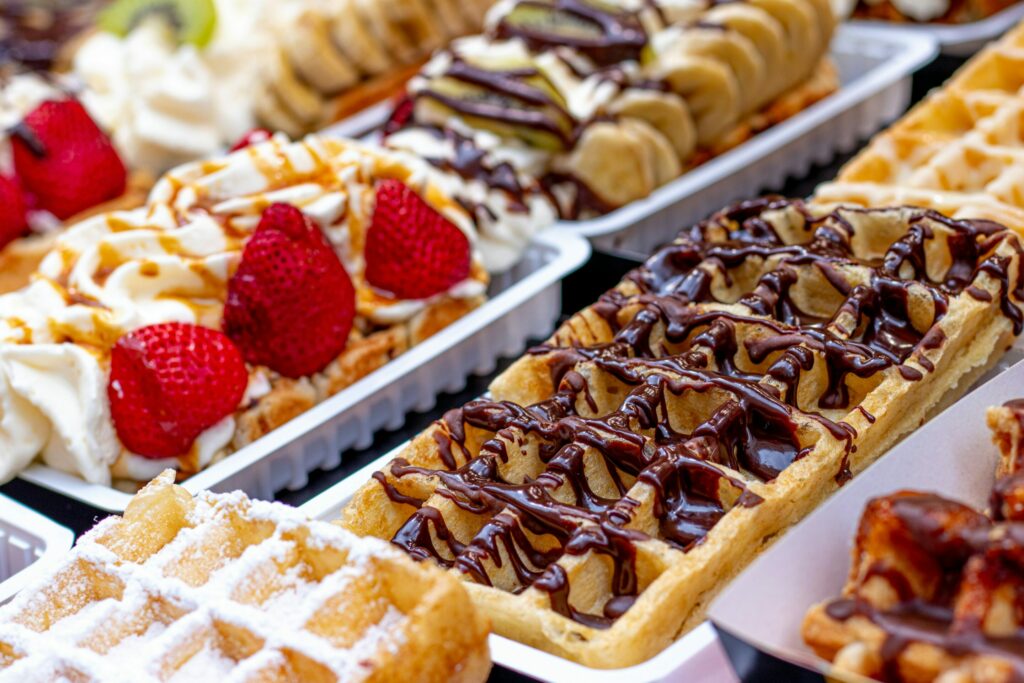Belgium has six governments, three languages and countless types of waffles if you delve deep enough into history. Two recipes dominate today: the Brussels waffle and the Liège waffle. How did we get here? What is the difference? And are waffles really that divisive?
This sweet treat has been around since as early as the 15th century, although its cultural significance has evolved somewhat since then. Once a delicacy reserved for nobler folk, it spread to the masses in the form of an Easter treat. When Europe adopted the Gregorian Calendar in the 16th century, New Year celebrations shifted to 1 January and annual waffle appreciation followed suit.
Primarily a tradition belonging to the Low Countries (Belgium, Luxembourg and the Netherlands), regional variations emerged over the years. For instance, West Flanders offered the thin lukken waffle, traditionally baked at the beginning of the year in the hope it would bring good luck (geluk means 'luck' in Dutch).
By the 19th century, waffles were a popular custom sold in 'palaces' – mobile tearooms making their way around the Low Countries. In 1890, Belgian baker Jules De Strooper created an even thinner version of lukken and his son exported this adaptation to the US in 1964.

'Shrove Tuesday with waffle maker' by Pieter van der Heyden (1611-47). Credit: Musea Brugge
The Yanks got a whiff of the waffle and gave it the international acclaim it enjoys today. At a New York World Fair in 1964, the Belgian Vermersch family set up shop selling 'Bel-Gem Brussels Waffles', a name mistakenly interpreted as 'Belgian Waffles'. The treat is now inextricably associated with the country, but important distinctions between different types of waffles remain.
Brussels versus Liège
The two waffles which predominate today are the Brussels waffle and the Liège waffle. The former is more classical: an indented rectangle with a soft, light texture and a simple flavour. The latter is crunchier, more oval-shaped and has clumps of sugar in the dough.
For the most part, Belgians are quite blasé about their waffle preference; both are widely available in Brussels city centre and other tourist destinations and sales are about the same. However, things get more heated when the topic of toppings is broached.

Brussels waffles (Left) and Liège waffles (Right). Credit: Belga / X
A Brussels waffle is typically slathered in butter or cream (icing sugar and strawberries are acceptable too). While numerous other toppings are sold by vans and vendors dotted across the capital, overdoing it is frowned upon by the most passionate of waffle lovers. "Anything else is blasphemous, especially when eating this waffle in the street," according to Belgian baker Regula Ysewijn.
Adding to a Liège waffle is considered even more scandalous, as the recipe already includes "sugar nibs" (a Belgian ingredient) and the experience of discovering these gems would be "completely ruined by any topping," underlined Ysewijn.
'Waffle-iron politics'
As tempting as it is to lean into polarising binaries like the Brussels versus Liège dichotomy, the unifying symbolism of waffles is worth highlighting too.
'Waffle-iron politics' refers to a political strategy aiming for budgetary balance between Wallonia and Flanders, in operation until 1988. For every franc spent in one region, a franc was spent on a similar project in the other. In other words, both sides of the iron are needed to make a waffle.
However, in typical Belgian fashion, the strategy was not as straightforward as that and engendered multiple "large, useless works", such as a disused motorway in Machelen and a bridge leading nowhere in Varsenare. It is also blamed for pushing the national debt to unprecedented levels in 1981.
'Waffle-iron politics' is effectively a thing of the past now, except for federal competencies such as railway infrastructure: 60% of funds are allocated to Wallonia and 40% to Flanders.

